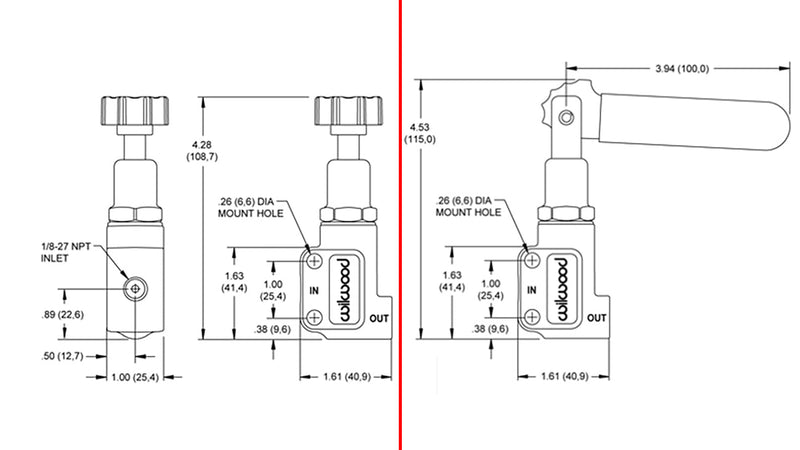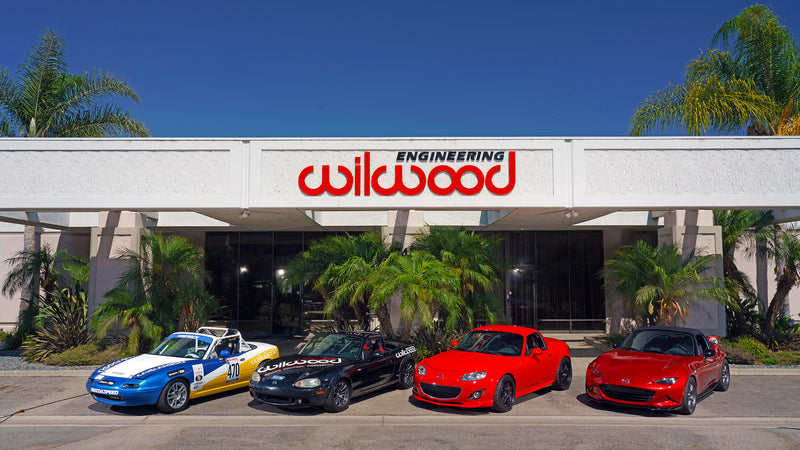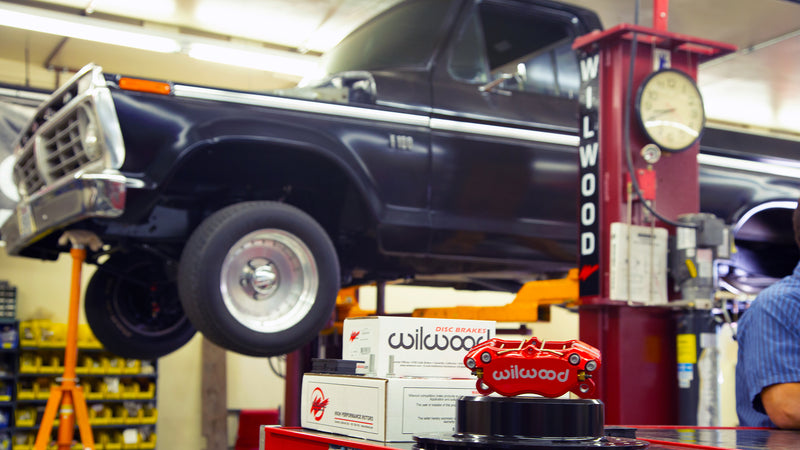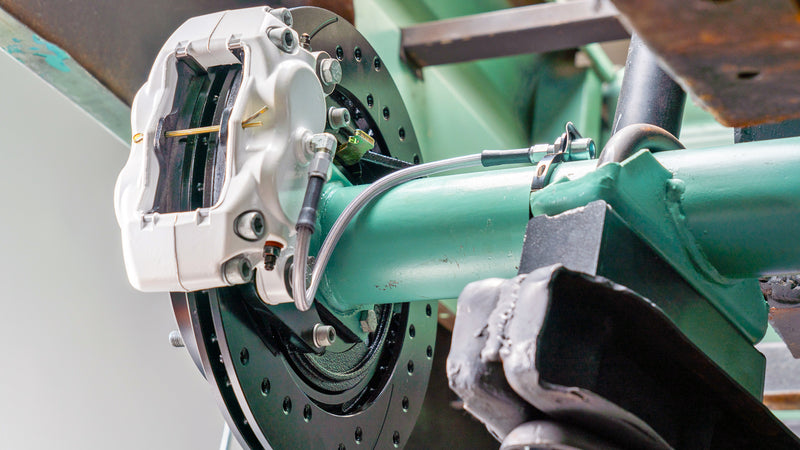
When setting up a street car for performance driving or converting a classic to disc brakes, it is essential to include an adjustable proportioning valve in your brake system. This valve is typically plumbed into the rear brake line or built into the combination valve below the master cylinder. There is some confusion, though, about what these valves do, how they do it, and how to properly adjust them.
With a typical tandem master cylinder, the amount of brake line pressure delivered to each outlet will always be the same without a proportioning valve. However, since rear wheels don't have as much traction (in a stop), and rear brakes don't do as much, you need a way to adjust that pressure. Race cars with separate front and rear master cylinders use different bore sizes in the calipers and master cylinders so that the rear gets less pressure at all times, but even they sometimes employ a proportioning valve.
The name "proportioning valve" seems to confuse people. The valve is more of a pressure regulator, decreasing how much pressure goes through it by a set amount (once initial pressure reaches a certain point). Reducing the force going to one circuit doesn't increase the force going to the other brake circuit. However, when the valve reduces pressure to one circuit, the proportional relationship between the front and rear braking (front to rear brake bias) changes.
Adjusting the valve does not directly change how much pressure goes to the brakes it is plumbed into; it is not like a hose spigot. Adjusting the knob or lever changes the pressure level at which the valve is triggered; sometimes called the "knee point" because it is the point where, on a graph of brake pressure, the line bends. It may seem counterintuitive, but when the knob or lever is adjusted all the way out, the valve delivers the most substantial reduction to maximum pressure. Screw it in, or click the lever over the other way, and the proportioning valve will allow a greater amount of pressure to reach the rear brakes before proportioning is triggered.
In Normal Driving
When you drive down the street in regular traffic, you seldom use the brakes hard enough to risk locking them up. In most everyday use, the proportioning valve doesn't do anything at all. In low-pressure brake applications, the rear brakes do a larger share of the braking because there is less brake dive from weight transfer to the front. As a result, there is little chance of the rear wheels locking up.
You save wear on the front brake pads by letting the rear brakes take more responsibility under light braking. In a hard stop, you want the front wheels to lock up slightly before the rear to prevent a spin.
A front-wheel brake bias has the same goal, no matter if it is baked into the size of the front and rear caliper pistons, limited with a proportioning valve, or set with a race car’s different sized master cylinders and balance bar. That goal is to reduce the amount of line pressure going to the rear brakes to prevent lock-up. Because braking causes most of the vehicle's weight to transfer to the front wheels, beyond a certain level of deceleration, the less traction the rear tires have and the less line pressure they can handle without locking up.
The proportioning valve lets you adjust the rear brake pressure to account for different tires, front to rear weight bias, and the effectiveness of rear disc or drum brakes.
How it Works
The inner workings of an adjustable proportioning valve are relatively simple but deceptively complex. Inside is a piston with less effective surface area at one end than the other, and a spring with a knob or lever controlling preload. The differential piston areas determine the fixed proportioning rate.
In everyday driving, the valve does nothing, with 100% of brake line pressure going through the valve as if it weren't there. Once the force on the larger area piston (the outlet line to the rear brakes) exceeds the preload force on the spring, the piston moves, cutting off the inlet from the outlet. Once the piston is unseated, the pressure from the master cylinder pushes on the smaller upper part of the piston, which moves the larger lower piston, transmitting pressure through the fluid to the rear brakes. Once closed, an increase in pressure from the master cylinder acting on the smaller area of the piston will open the valve again, allowing pressure to increase to the rear brake line. The pressure increase happens at a lesser proportion and then the increased line pressure again closes the valve.
The cycling of the valve happens very rapidly, too rapidly to be noticed by a driver, but our engineers have confirmed it in test rigs in the lab.
The different-sized ends of the pistons have a hydraulic disadvantage. Line pressure is in pounds per square inch, so, (without the preload spring in the system) 1000 psi pushing on the smaller side of the piston, connected to a piston with 57% greater surface area, results in just 430 psi in the chamber on the other side. In actual use, with the preload at different settings, you can see how much output you get for a specific input on the graph below.
If you graph the line pressure at the rear brakes compared to the master cylinder, the slope of the curve changes noticeably once it passes the point where the valve closes. This bend in the line on the graph is where the term "knee point" comes from. The full line pressure reaches the rear brakes until line pressure overcomes the preload on the proportioning valve spring. From that pressure up, it delivers only 43% of the additional force to the rear brakes.
It can be helpful to think about it this way: Once the proportioning valve is triggered closed, it is as if the master cylinder is controlling a slave cylinder, and the slave cylinder pushing another piston. That second piston then controls pressure to the rear brake circuit. All of this is contained in a valve that's the size of your thumb.
When adjusting the proportioning valve, you increase or decrease preload on that spring pressing on the piston. More spring preload (screwing the knob or clicking the lever inward) allows more line pressure before the valve closes and proportioning begins. Conversely, decreasing the spring preload triggers the valve to close at a lower pressure, moving the "knee point" down the graph. The lesser the spring preload, the lower pressure the valve is triggered at, the lower the ultimate amount of pressure delivered to the rear brakes.
Wilwood Proportioning Valves
Wilwood makes three different styles of adjustable proportioning valve, including one designed to replace the factory combination valve and make plumbing easier. All three are based on the same internal design with the same strength spring. Wilwood's adjustable proportioning valve activation range goes from approximately 150 psi at minimum preload to 1200 psi at maximum.
The knob style valves allow infinitely variable adjustment, with approximately ten rotations from minimum to maximum. The lever style has six different settings, making it easy to adjust the brake bias quickly while racing, even in the middle of a lap. The six positions on the lever are approximately 150 psi, 360 psi, 570 psi, 780 psi, 990 psi, and 1200 psi.
The pressure delivered to the rear brakes is always directly proportional to the amount created at the master cylinder. Adjusting the valve adjusts the point at which that relationship changes, but it doesn't change the relationship. Below the trigger PSI needed to close the valve, it is a 1:1 relationship, and above that pressure, it is less than 1/2:1. The maximum pressure sent to the rear brakes is a function of the point at which the valve closes.
Set midway in the knob’s adjustment range, the valve is triggered at approximately 675 psi. From 1-675 psi, 100% of that pressure goes directly to the rear calipers. From 676 psi to the limit of your leg strength, just 43% gets through. If the master cylinder is putting out 1000 psi during a hard stop, the rear brake lines would have 675 psi, plus 43% of the additional 325 psi, for a total of 815 psi going to the rear calipers.
| lever/knob position | trigger PSI | PSI at rear brake line | PSI at rear brake line | PSI at rear brake line | PSI at rear brake line | PSI at rear brake line |
| (with 300 psi from M/C) | (with 600 psi from M/C) | (with 900 psi from M/C) | (with 1200 psi from M/C) | (with 1500 psi from M/C) | ||
| notch 1/fully out | 150 | 215 | 344 | 473 | 602 | 731 |
| notch 2 | 360 | 300 | 463 | 592 | 721 | 850 |
| notch 3 | 570 | 300 | 583 | 712 | 841 | 970 |
| midway (knob only) | 675 | 300 | 600 | 772 | 901 | 1030 |
| notch 4 | 780 | 300 | 600 | 832 | 960 | 1090 |
| notch 5 | 990 | 300 | 600 | 900 | 1080 | 1209 |
| notch 6/fully in | 1200 | 300 | 600 | 900 | 1200 | 1329 |
Why You Need One
Unless you track your car, a brake application that could lock up the rear brakes is a 1 in 100 or even 1 in 1000 occurrence. But when do you have to slam on your brakes? The last thing you want is the car's rear to step out and come around on you.
The vehicles that most need a proportioning valve have discs in the front and drums in the rear, which describes most disc brake conversions. When converting a drum brake car to front discs, or upgrading factory discs to Wilwood performance brakes, you dramatically change the brake bias compared to a four-wheel drum car or factory disc/drum car.
Install four-wheel discs on a formerly rear drum brake car (with the factory master cylinder and combination valve), and you may not get much rear braking at all. This is because drum brakes lock up at a much lower pressure than discs (the non-adjustable valves often kick in at less than 400 psi). The factory, non-adjustable proportioning valves only work in the narrow confines of the system, cars, and tires they were designed for. (There may also be a residual pressure valve involved that should be removed as well.)
In most drum brake setups, the spinning drum increases the force with which the shoes press into the brake lining; they are self-energizing. Early disc/drum cars needed proportioning valves that kicked in at low line pressure because brake dive and tire traction were much worse than now. The lower line pressures needed for drum brakes, and the sudden weight transfer when you step on the pedal, make it nearly impossible to keep them from locking up without a proportioning valve limiting the pressure.
Cars with drum brakes on all four wheels don't always require a proportioning valve on the rear line. Some big heavy vehicles in the 1960s with a lot of weight over the rear wheels didn't even have factory-installed proportioning valves. At the opposite extreme, some trucks still have mechanical proportioning valves that dramatically vary the pressure to the rear wheels based on the load in the bed.
Modern computer stability control and antilock braking systems adjust brake bias for you dynamically and can even apply the brakes of just one wheel at a time. The adjustable balance bar bias system in race cars can be set up nearly perfectly because, in a race car, most brake applications are made with maximum effort. An adjustable proportioning valve works well for most street applications, and once set up, doesn't require fiddling with unless you change things; fitting different wheels and tires, for instance.

Proper Initial Adjustment
For safety, start with the proportioning valve set with maximum reduction setting, knob fully screwed out, and work from there. Next, find an assistant to observe and an empty parking lot with no chance of hitting anything. You'll need to repeatedly stop from 30 mph with the wheels locked up without attracting too much attention.
- Make sure your tires are correctly inflated to the recommended pressures.
- For best results, you'll want half a tank of gas or less, no passengers, and minimal junk in your trunk.
- Accelerate to 30 mph, then stop hard enough to lock up the wheels.
- Have your assistant watch (from a safe distance) and confirm that the front and rear wheels lock.
- If only the front locked, adjust the knob in two full turns to allow more pressure to the rear brakes and test again.
- Continue adjusting in, two turns at a time, until the front and rear wheels lock in a hard stop.
- Adjust knob out one complete turn and test again.
- Continue these adjustments 1/2 turn in or out at a time until maximum braking can be achieved and no wheel rear lock is observed.
- Test the vehicle again at 50 mph to judge the effects of a more dramatic weight transfer and make any additional adjustments as needed. Typically by turning the knob out to decrease pressure to the rear.
When bleeding your brakes, it can be helpful to turn the proportioning valve all the way in to make bleeding easier. Make a note of how many rotations it takes to fully in, then adjust back out the same amount when finished with bleeding.







Further to my comment: Should I have a 2# RPV in the line to the front disks? I put a 10# in the line to the rear drums.
Rob
Great article. I understand better now why I should have a proportioning valve and how to set it up. I’ve got a 51 Merc (Canada) PU that I built 7 years ago and just had to change the front pads. I noticed the pedal was mushy (prob always was) and decided to make it right. I think I understand how to do it now.
Thanks
Rob